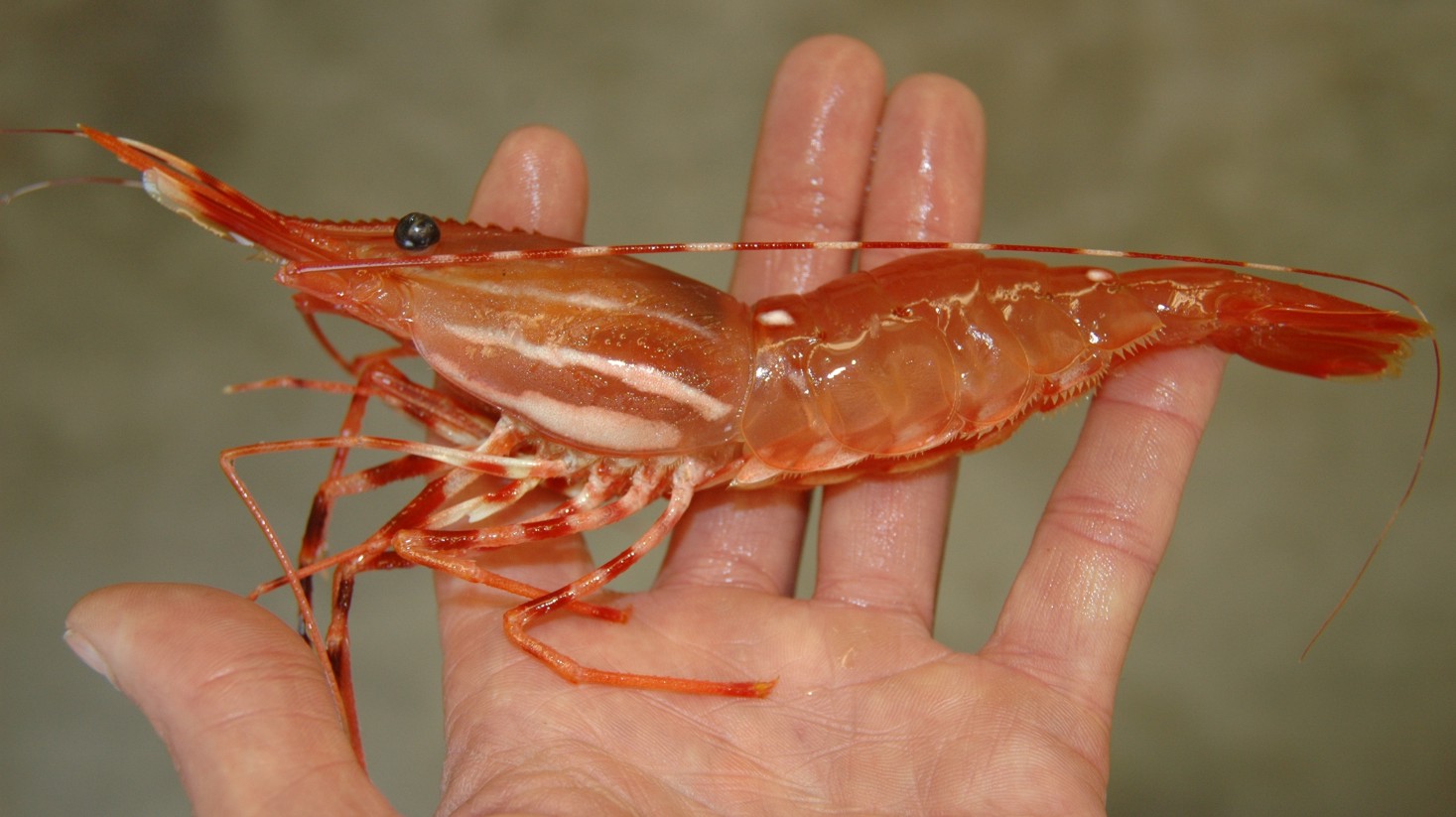Pandalus platyceros Brandt, 1851Common name(s): Spot shrimp, Spot prawn* |
|
| Synonyms: | 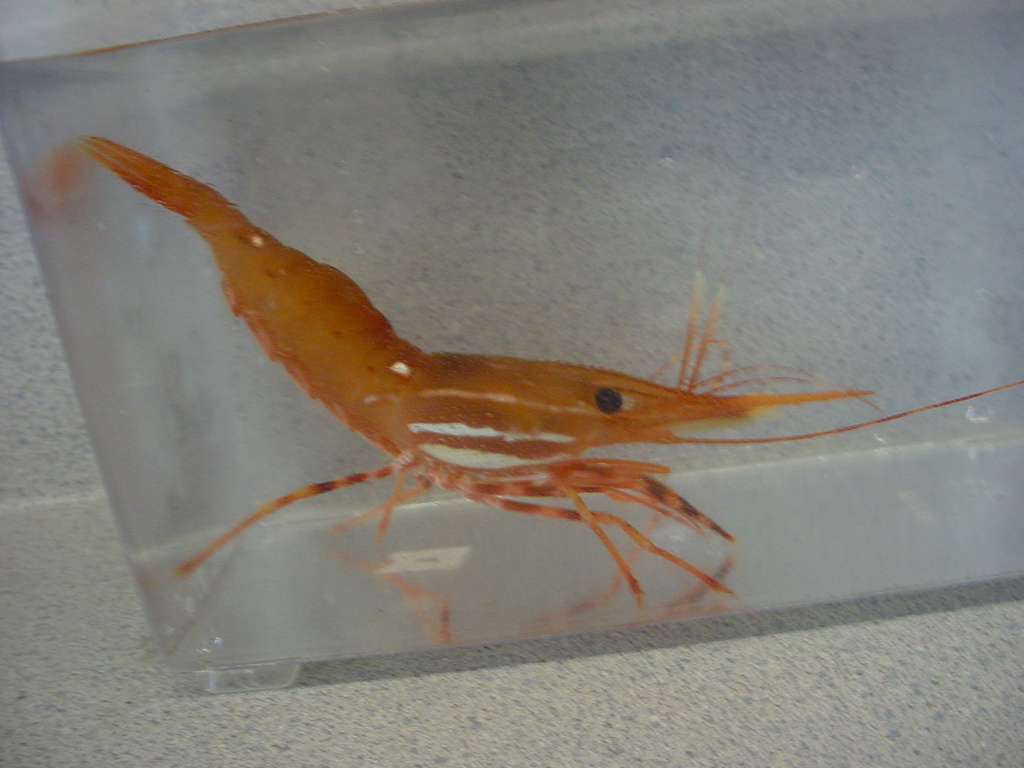 |
| Phylum Arthropoda
Subphylum Crustacea Class Malacostraca Subclass Eumalacostraca Superorder Eucarida Order Decapoda Suborder Pleocyemata Infraorder Caridea (true shrimp) Family Pandalidae |
|
| Pandalus platyceros from 100 m depth in San Juan Channel. Length about 20 cm | |
| (Photo by: Dave Cowles July 2004) | |
How to Distinguish from Similar Species: This is the largest shrimp on the west coast of North America. The large size and white spot on the abdomen are distinctive. Pandalus tridens has a 6th abdominal segment 3 times as long as wide.
Geographical Range: Unalaska, Alaska to San Diego, CA; Sea of Japan and Korea Strait
Depth Range: Low intertidal to 487 meters. Mostly well below the intertidal zone.
Habitat: Subtidal rocky and sandy habitats. We frequently catch them on by otter trawl in the San Juan Channel on bottoms of shelly hash. Juveniles come shallower, even into the lower intertidal zone where they hide in crevices and under boulders during the day.
Biology/Natural History: A common inhabitant of deep sandy bottoms in the Rosario area. Feed on crustaceans, polychaetes, limpets, and carcasses. One important predator is the giant octopus Octopus dofleini and the yelloweye rockfish Sebastes ruberrimus. One interesting feature about this species is that it has a different number of multiarticulations on the carpus of its two second pereopods: The left pereopod has 27-31 articles and is longer, while the shorter right second pereopod has only 8 or 9 articles on the carpus. Breeding ends in late October. Females carry their eggs on the abdomen for 4-5 months, remain in deep water. Eggs hatch in March or April. Larvae settle from the plankton in May and June. Juveniles feed in shallow water during summer, especially among Agarum fimbriatum and A. clathratum kelp. They seem to avoid Laminaria saccharina. During their second fall (carapace length 2.8 cm) they become males, which they remain until they grow to 3.3 cm carapace length, at which time they become females. Females may mate only once. May not live longer than 4 years. These shrimp are very common on the bottom in the deeper portions of the Salish Sea. At depths over 70 m in the Salish Sea area they aggregate on shallow-slope bottoms near deposits of drift kelp, on which they feed (Britton-Simmons et al., 2012)
The full genetic sequence of the species' mitochondria was published by Cronin et al., 2022. The species' mitochondrial genome is 16,628 base pairs long and contains 13 protein-coding genes, 2 ribosomal RNA genes, and 24 transfer RNA genes.
| Return to: | |||
| Main Page | Alphabetic Index | Systematic Index | Glossary |
References:
Dichotomous Keys:Kozloff 1987, 1996
Wicksten, 2009
General References:
Lamb
and Hanby, 2005
O'Clair
and O'Clair, 1998
Scientific Articles:
Britton-Simmons, Kevin H., Alison L. Rhoades, Robert E. Pacunski, Aaron W.E. Galloway, Alexander T. Lowe, Elizabeth A. Sosik, Megan N. Dethier, and David O. Duggins, 2012. Habitat and bathymetry influence the landscape-scale distribution and abundance of drift macrophytes and associated invertebrates. Limnology and Oceanography 57:1 pp. 176-184
Cronin, Timothy J., Steven J.M. Jones, and J. Antonie Baeza, 2022. The complete mitochondrial genome of the spot prawn, Pandalus platyceros Brandt in von Middendorf, 1851 (Decapoda: Caridea: Pandalidae), assembled from linked-reads sequencing. Journal of Crustacean Biology 42:1, ruac003, https://doi.org/10/1093/jcbiol/ruac003
Komai, T., 1999. A revision of the genus Pandalus (Crustacea: Decapoda: Caridea: Pandalidae). Journal of Natural History 33: pp 1265-1372
McFadden, Melissa A., 2004. Living without
oxygen: The anaerobic
metabolism of Hemisquilla
californiensis. M.S. thesis, Walla Walla
College Dept. of Biology. 58 pp. Though the primary
species
studied in this thesis was the mantis shrimp Hemisquilla
californiensis,
the control species was Pandalus platyceros.
The abstract
follows:
Hemisquilla californiensis (Stomatopoda:
Hemisquillidae) is
a burrow-dwelling mantis shrimp that routinely encounters hypoxic
conditions
and can survive more than 48 hours in complete anoxia. We
compared
the properties of this species' tissue and hemolymph to those of the
spot
shrimp Pandalus platyceros (Caridea: Pandalidae),
which inhabits
an aerobic environment and dies within a few hours of anoxia, to find
the
biochemical adaptations that allow Hemisquilla to
survive in low
oxygen. Both species accumulated lactate under anaerobic
conditions,
with the greatest levels in the hemolymph. Hemisquilla
accumulated
lactate more slowly than did Pandalus and tolerated
a much higher
lactate concentration in the blood before death. Slightly
elevated
alanine levels were observed during anoxia in both species.
The buffering
capacity of the tissues analyzed in Hemisquilla was
no greater than
that in Pandalus, providing no added protection
against acidification
during anaerobiosis. However, Hemisquilla
tolerated a two-fold
greater decrease in hemolymph pH before death than did Pandalus.
The capacity for survival in anaerobic conditions shown by Hemisquilla
is due both to a mechanism for reducing the rate of lactate buildup in
the blood and to an increased tolerance for lactate and acidosis.
General Notes and Observations: Locations, abundances, unusual behaviors:
*Note on shrimp vs prawns: In most of the world, members of infraorder Caridea are known as shrimp and members of infraorder Penaeidea are known as prawns. In the United States, however, these terms are used much more loosely. Often any shrimplike animal which has a large body and walks along the bottom is called a prawn. I prefer to use the terms as the rest of the world does since that makes more taxonomic sense.
This species is fished commercially (mainly via shrimp pots) from Alaska to northern California.

Photo by Dave Cowles, July 2000

Photo by Dave Cowles, March 2004
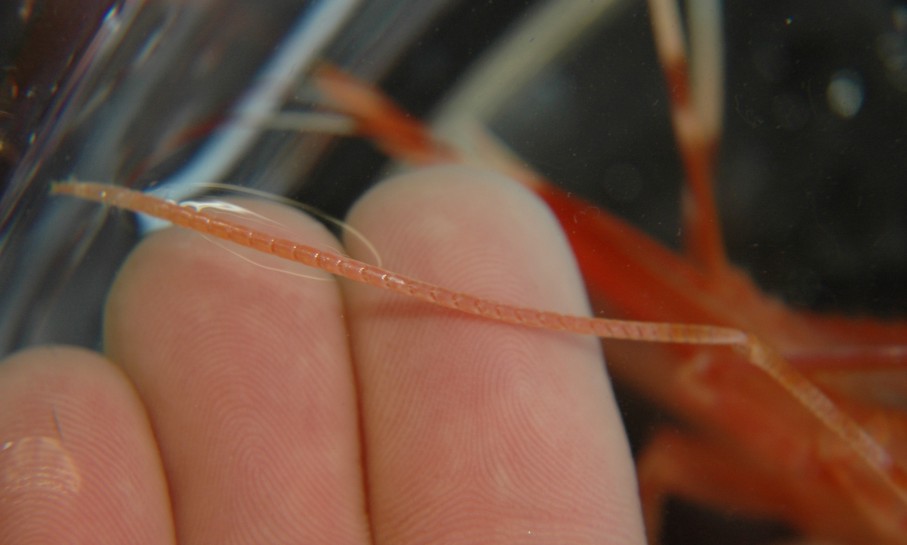
The carpus of pereopod 2 is subdivided by many annular striations into
a flexible series of many articles. This structure is called
a multiarticulated
carpus.
Pandalids have many articles (more than 7) on the carpus of the 2nd
pereopod, and usually have around 20.
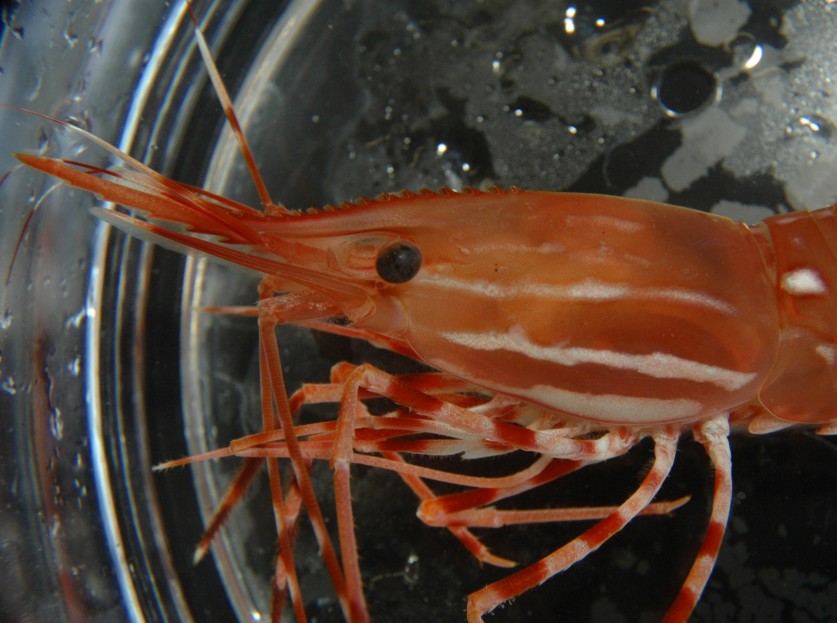
Pandalus platyceros has a long rostrum which is
longer than
the rest of the carapace. It has movable dorsal spines which
continue
out to at least part of the distal half of the rostrum.

Abdominal segment 3 has no mid-dorsal carina (ridge) or spine.
Note how the pleurite of segment 2 expands and overlaps that of
segments
1 and 3, as is characteristic of caridean (true) shrimp.
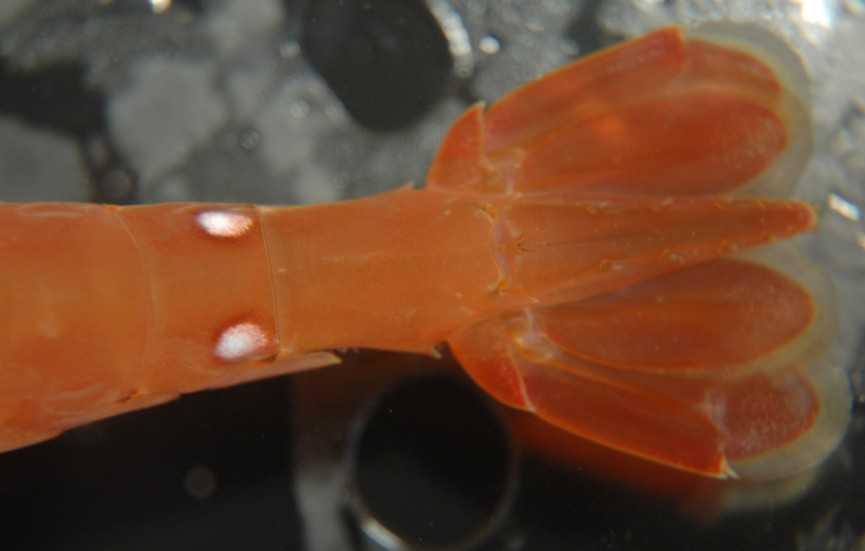
Abdominal segment 6 is less than twice as long as it is wide.
This scar on the abdomen is the result of the outgrowth of the externa
of the parasitic barnacle Sylon hippolytes.
Photo provided by Hilary Wood of the Alaska Dept. of Fish and
Game.
Authors and Editors of Page:
Dave Cowles (2005): Created original page
